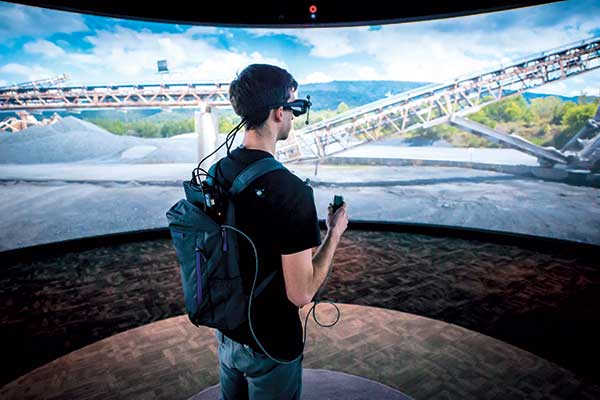Recognizing hazards to avoid accidents
Researchers at the National Institute for Occupational Safety & Health (NIOSH) are studying how workers in the stone, sand and gravel industry search for and find hazards in their work environment. Data collection is currently underway.
Mine workers, safety professionals and mining students are visiting the Pittsburgh research laboratory and viewing panoramic images of the pit, plant, shop and roadway at a surface stone mine. Participants are asked to identify hazards in these images while researchers track where and how they are looking. Participants then sit down with researchers and discuss the hazards they identified and/or missed.

Participants in the NIOSH study wear eye-tracking spectacles in the NIOSH VISLab while searching for hazards in large panoramic pictures from a stone mine. These pictures include a variety of hazards (e.g., electrical, slip and fall, missing berms, etc.), and participants are instructed to search the panoramic image to find all potential hazards. The eye-tracking spectacles record where the participant is looking. Story and photos by NIOSH Pittsburgh Mining Research Division.
The group’s initial data analyses from the Virtual Immersive Simulation Laboratory (VISLab) research show several interesting results. First, mine workers are generally more knowledgeable about hazards that occur at their typical work location. For instance, front-end loader and haul truck operators who spend a majority of their days loading in the pit are able to correctly identify more highwall and loading hazards than workers who spend time at other locations at the mine site.
Also, mine workers from the same mine site are more likely to identify and then talk about issues that are critical to their specific work site. For example, all participating mine workers from one site focused on issues related to berms – inadequate berm height, missing berms and shallow catch berms. During discussion, it became clear that berms were critical to these workers, first because of the material they mine and second because this was an issue that was identified during a recent Mine Safety & Health Administration inspection.
Overall, these initial observations indicate that what workers identify as hazards can be affected by the environment where they work and also by what has already been identified as hazards to address.
Initial findings
Based on these initial results, NIOSH suggests the following considerations for mine operators and safety professionals when designing and implementing new training to improve hazard recognition and risk perception:
- Recognize that hazard recognition training is not one-size-fits-all. Each mine site and each work location at a mine site has its own specific hazards. Highlight those site-specific hazards that are critical for your mine workers to know and understand. An example specific to ground control would be to make sure your mine workers are knowledgeable of potential precursors of highwall falls or rockslides, such as cracks or sloughing. This will help them find and potentially fix problems before they happen.
- Encourage mine workers to discuss both typical and atypical hazards found at their work locations. This is not only a helpful reminder for those who spend a majority of their time in a particular location (e.g., the shop), but also a learning tool for those who work intermittently at a location (e.g., the pit). For example, front end loader and haul truck operators can be encouraged to discuss potential dangers of working too close to the highwall. This is a typical hazard and a critical issue to be aware of when working in the pit, but something that may not be obvious to a general laborer who spends the majority of his or her time performing maintenance around the plant.
Next steps
NIOSH is continuing data collection with health and safety professionals, experienced mine workers, new mine workers, and students enrolled in mining engineering and health and safety programs. Results will be used to design recommendation documents and training materials focused on improving mine workers’ knowledge, skills and abilities related to the detection of hazards and perception of risks specific to stone, sand and gravel mining so that they are more successful at searching for and finding hazards during workplace exams. In addition, an increased knowledge of hazards will contribute to a better understanding of risk, which is critical to helping mine workers identify, mitigate and remove hazards.
Authors Brianna Eiter, Jennica Bellanca, Timothy Orr, William Helfrich, Jason Navoyski, and Brendan MacDonald work at the NIOSH Pittsburgh Mining Research Division. NIOSH is currently collecting data from aggregate-operation workers and safety professionals. If you are interested in participating in data collection or in learning more about this research project, contact Brianna Eiter, beiter@cdc.gov.









